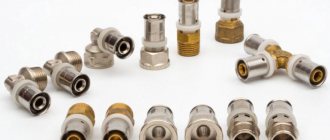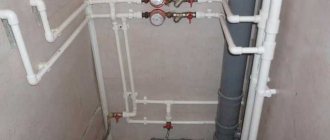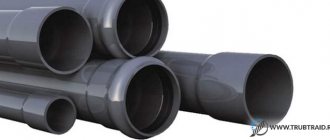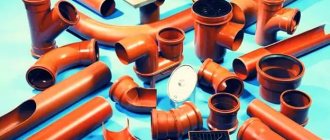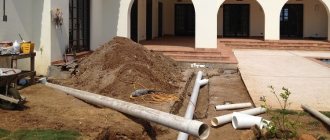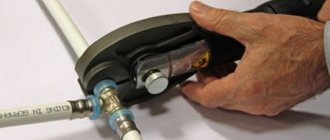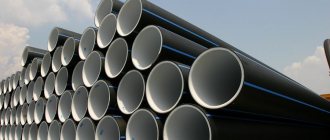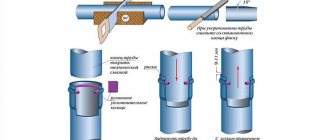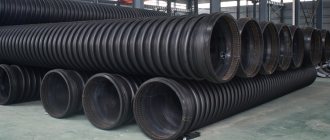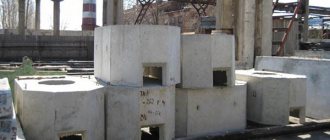List of tools required for work
Having made the calculations and purchased the required amount of material, you should stop at purchasing the most necessary tool. To install metal-plastic pipes, especially with your own hands, just pliers and a flat-head screwdriver will not be enough, so it’s better to spend a little money, but have everything you need at hand.
What you must buy:
- Pipe cutter The tool that should be purchased first. Using this device you can achieve smooth edges without any burrs or other damage.
High-quality and durable pipe cutter
- Press jaws. They belong to the category of crimping tools, using which you can connect two pipes by placing a press fitting on them.
- Calibrator. The calibrator is used for proper flaring, during which the surface of the metal-plastic product is not damaged.
Inexpensive calibrator
- Bevel remover. If the cut was made incorrectly or crookedly, then using a chamfer remover it can be given the correct shape.
- Set of open-end wrenches. For greater savings, you can purchase one adjustable wrench.
After collecting the necessary tools, you can proceed directly to the connection. But to do this, you should familiarize yourself with the methods of connecting or soldering metal-plastic pipes.
Required materials and tools
Soldering iron for PVC pipes
Metal-plastic products are connected only using metal fittings. Polyethylene pipes are also connected only mechanically, using fittings made of polypropylene and brass. Polyvinyl chloride products are mounted using special glue.
Polypropylene products are quite easy to install. High quality of the connection is achieved using the diffusion connection method, which takes place at a temperature of 260 degrees Celsius.
A special cooking apparatus or soldering iron is used for this. The three main steps in welding are cutting, heating and joining, which do not take much time. To secure pipes together, various fittings are used: tees, adapters, angles.
To perform soldering yourself, you will need the following set of tools:
- roulette;
- cutting scissors – pipe cutter;
- marker;
- welding device for soldering;
- building level;
The welding device is a small device that has a handle for holding and a base with heating elements. Special nozzles are inserted into it, corresponding in diameter to various products. There is a regulator for the required temperature on the body.
What is a compression fitting and how to use it
Compression fittings are often used not only by DIYers, but also by professional plumbers. So why are they so popular? The answer is simple: because of the mass of positive qualities and ease of installation.
Compression fitting
- To install a compression fitting, no specialized equipment is required; all you need to do is have an adjustable wrench on hand.
- Such products even tolerate burrs along the edge, so a pipe cutter may not be used here.
- There is no need to use a bevel remover or calibrator.
The installation sequence of the compression fitting is as follows:
- The nut, which has free play and is tightened after installation, is placed on the end of the product.
- The shank is wrapped several times with tow to make the connection more tight, and inserted into the product.
- A fixing nut is placed on the base of the fitting. Use one wrench to hold the body of the product, and the second to tighten the nut.
The simplicity of such installation can be deceptive and not many home craftsmen are able to make the correct connection the first time. When tightening the fixing nut, pay attention to the force applied, as the body of the compression fitting may crack.
Important! Before installing the product, be sure to check the presence of all O-rings, as well as fitting gaskets, which provide the required level of sealing. If they are absent, the connection will not be reliable and will require immediate replacement.
Advantages and disadvantages
Each type has its own advantages and disadvantages.
PVC products
They appeared quite a long time ago and were used for individual plumbing systems. Their choice in diameter is small, which does not allow them to be used everywhere.
Their advantage is a fairly simple connection using glue. But recently they began to abandon this type, since tests have proven that over time, when used, the material begins to produce toxic substances. Also, the disadvantage of this type of pipe is its flammable properties and low fire safety, the release of toxic substances during combustion.
Cross-linked polyethylene and regular
Polyethylene pipes have been used for a long time, mainly for cold water supply. Since under the influence of high temperatures the strength of these products is significantly reduced. Direct sunlight also has a negative effect on them, so this type can only be used indoors.
The advantage of this material is its resistance to negative and low temperatures. Therefore, their installation can be carried out in the winter season.
Later, this type was improved and an analogue made of cross-linked polyethylene was released. Such products are more durable and resistant to high temperatures. They can be used for both hot water supply and heating systems.
Metal-plastic
These products consist of several layers of materials - cross-linked polyethylene, an adhesive layer, aluminum foil and a protective shell. Such pipes are resistant to oxidation.
Their flexibility allows you to make complex designs and connect to various devices. The downside is the small maximum diameter - only 40 mm. This significantly limits the scope of application. Fastening with metal fittings quickly deteriorates when exposed to water with a high chlorine content.
Polypropylene
This new generation of plastic pipes has become widespread and very popular due to its many advantages compared to products made from other materials.
The main ones can be called:
- Durability.
- Resistance to chemical corrosion, solvents and chemical reagents.
- There is no heat loss, which allows them to be used without additional insulation.
- Light weight and easy to install.
- Nonconductivity of stray currents.
- No condensation on the surface.
- No lime deposits.
- They do not affect water quality and do not contribute to the accumulation of harmful bacteria and microorganisms.
- Reduced resistance to internal water flow due to smooth walls.
- Good internal sound insulation.
- Versatility of use and affordability.
- Large temperature range for use – from -10 to +90 degrees Celsius.
It can be noted that when water freezes in pipes, they do not cause significant harm. These products do not harm humans or the environment and are safe to use. Added to the advantages is the absence of the need for painting and additional processing.
Installing a push fitting with your own hands
The most simplified product, for installation you don’t even need an adjustable wrench, just the right hands. The installation sequence is as follows: take the push fitting and insert the pipe into it until it stops. To determine the force, just look into the special control hole - as soon as the end of the product appears in it, you can stop pushing.
Push fittings for quick installation
Push fittings are especially relevant when the question arises of how to quickly connect a metal-plastic pipe to a metal one. There are many advantages of this connection:
- As mentioned earlier, no tools are required for installation. Only push fittings and products that need to be connected.
- Push fittings have a long service life and are made of durable and reliable materials.
- Can be wall mounted, unlike compression fittings. It’s very convenient when you don’t want to constantly monitor and tighten the connection.
Push fittings have a lot of advantages, but they also have one significant drawback - high cost. It is better not to purchase cheap products, since their service life decreases in proportion to the price. You should contact a plumbing store where you can choose connections from reputable manufacturers.
What tools are used during installation?
- Soldering iron - it is used to achieve a tight connection. A soldering iron is a necessary element for diffusion welding. For household use, a soldering machine with a power of 900 to 1200 W is suitable. It is convenient when the soldering iron has a stand for stationary use, a power regulator and is equipped with an automatic cooling and heating system;
- Soldering nozzles. Standard sets have 3-4 nozzles. Try to buy attachments that have a good non-stick coating, it prevents plastic from sticking to the tool;
- Powerful scissors for plastic;
- Tool for removing aluminum foil and chamfering from pipes. As a rule, it is not included in soldering kits, but this tool allows you to do soldering faster and more accurately;
- Calibrator;
- Drill;
- Open-end wrenches and pliers.
Press fittings
Very similar to compression products, but with some differences. Press fittings can be called a more productive form of connections, since they have a long service life, but require the use of appropriate tools. If installed correctly, press fittings can be installed in walls.
High-quality and reliable press fittings
Main differences from compression products:
- Low seating of the rubber seals, resulting in better tightness. The gasket tightly compresses the metal-plastic product along the internal diameter.
- The fixing nut was replaced by a crimp sleeve, for clamping which press pliers are used. The sleeve is made of stainless steel, not affected by moisture in the water supply system. It is precisely because of the use of a crimping tool that press fittings can be mounted in walls.
The installation sequence is the same as in the case of compression products. Place the fitting onto the end of the product and clamp it using press pliers. The installation process is simplified due to the absence of a fixing nut.
Manual press pliers for crimping fittings
This type of fitting has practically no disadvantages, except for the high cost of the tool. The price of pliers for crimping sleeves on metal-plastic pipes starts from 6,000 rubles. The category of professional tools is already above the 10,000 mark.
Areas of application of metal-plastic elements
Polymer pipes with a layer that imparts higher rigidity are used in a number of cases:
- heating system;
- installation of water pipelines for transporting hot and cold liquids;
- sewerage laying;
- arrangement of heated floors;
- installation of electrical wiring (pipes are used to protect the cable);
- gas supply;
- transportation of aggressive media;
- irrigation system;
- installation of lines through which compressed air will pass.
It is prohibited to use metal-plastic products when constructing pipelines at facilities with increased fire hazard (category D), for the purpose of installing heating systems operating through elevator units.
Soldering of metal-plastic pipes
The main types and methods of connecting metal-plastic pipes were discussed above; now you need to move on to soldering. You should immediately outline the list of tools required for soldering metal-plastic products. You will need:
- Soldering iron or welding machine for soldering plastic, polypropylene and metal-plastic products. The average cost is from 1500 to 2500 rubles. A higher price means additional display or multiple modes.
- Sealant. It is better to choose a sealant that is not affected by high temperatures, but as a cheaper option you can purchase a simple one.
- Tow. Which is used in almost all plumbing work.
Soldering irons or welding machines are divided into home and professional models. Their main difference is that professional soldering irons can solder pipes with a diameter exceeding 50 cm, but for home needs this will be overkill.
Special apparatus for soldering metal-plastic pipes
How to properly solder metal-plastic pipes:
- Cut the pipe evenly, ensuring that there are no burrs along the edges. If the edges are uneven or the surface is damaged, then soldering will not bring a positive result, and the whole process will have to be repeated again.
- Turn on the soldering iron and heat it to the nominal temperature. Use the cone-shaped part of the tip to heat the outer part of the pipe. For different diameters, a corresponding nozzle is installed on the soldering iron.
- Install the nozzle one size smaller than the previous one and thoroughly heat the inside of the metal-plastic product. The nominal temperature at which pipes are soldered is 180 degrees Celsius.
- After heating the outer and inner parts, connect the two pipes together. Wait until the products cool down. The soldering is now complete.
Made from polypropylene
This type is used more often than others.
The most common types of polypropylene pipes are PN16 , PN25 and composite (stabilized).
Composite ones are used in heating and water supply systems; this type can withstand high temperatures and pressure.
Composite options, in turn, are divided into subtypes:
- With stabilization along the outer diameter: during installation it is necessary to completely cut off the interlayer. Over time, they may delaminate.
- With stabilization closer to the inner diameter: this type does not have the above-mentioned disadvantages, the interlayer does not need to be cut off.
Today there are two types of interlayers used: aluminum and fiberglass. Both materials perform their function perfectly.
Soldering of polypropylene products
As a rule, polypropylene pipes are made 4 meters long, their diameter ranges from 1.6 to 12.5 cm. The type of welding is thermoplastic (hot soldering), which minimizes the risk of sealing - it all depends on the quality of the welding. Rubber, paronite, is used extremely rarely for this type of connection. The buyer can purchase pipes with fitting threads, which allows them to combine plastic pipes and already installed metal ones.
How to bend a metal-plastic pipe correctly
Very often, after connecting the pipes, the structure has to be bent in the right direction. If the technology for installing and connecting metal-plastic pipes is selected with high quality, then this will not affect the fitting or soldering in any way. But still, it is better to bend the pipe correctly, and there are several interesting ways to do this.
It is best to use a hair dryer. It is enough to slightly heat the area that needs to be bent, and then use your hands to give it the required shape. The heated metal-plastic pipe bends easily and does not deform. It should be remembered that the pipe should not be allowed to overheat, which can lead to damage.
Sometimes rigid springs, precisely selected in diameter, are used to bend metal-plastic products. The spring is not put on the pipe, but pushed inside it, this allows you to achieve the necessary rigidity. The middle of the bend and the middle of the spring must coincide exactly. And so that you can get it out later, a metal wire should be firmly tied to one end.
You can also use sand; it must be poured inside the metal-plastic product so that it is distributed evenly throughout the entire pipe, without hollow spots. Then the area chosen for bending is heated a little and given the desired shape with a smooth movement. When using sand, metal-plastic pipes do not deform and remain intact along their entire length.
If you need to bend products frequently and in large quantities, then it is best to purchase a pipe bender - a tool specially made for this purpose. Of course, its cost is high, but it allows you to simplify the task as much as possible. Some home craftsmen make pipe benders at home using scrap materials.
An example of an inexpensive pipe bender
Secrets of high-quality pipe welding
In order for the soldering of heating pipes to be of high quality and the connection to be flawless, you need to know the small secrets of this process:
- The pipe should not enter the fitting when cold.
- The operation of attaching parts to the soldering iron is carried out simultaneously, with pressure, but without twisting.
- The parts are connected without unnecessary pressure and without twisting.
- The parts are kept in a fixed state until they cool completely.
- The result of a high-quality connection is a uniform influx of plastic along the diameter of the pipe near the fitting.
If you are going to solder heating pipes for the first time, then purchase a couple of cheap fittings and some pipe supply. Practice beforehand to feel and understand the physical qualities of cold and molten material. For self-control, cut your connection and look at the quality of the soldering from the inside.
Preparation for installation
The installation of a pipeline should begin with a wiring plan. Based on the markings applied to the walls of the apartment, the total length of the pipeline and individual sections is determined.
Metal-plastic pipes will have to be connected using a fitting, so the calculation of these parts must be done simultaneously with determining the length of the pipeline.
After calculating the quantity, the necessary material is selected and purchased and the installation of metal-plastic heating pipes begins. In addition, you need to buy or rent special tools.
Tools
For cutting, a special pipe cutter is used, with the help of which the cut angle is strictly perpendicular to the longitudinal axis of the product. Sometimes metal plastic is cut with a hacksaw, but the quality of the cut deteriorates.
Whatever tool is used to cut the workpieces, the ends of the workpieces are still deformed.
A calibrator is used to restore the round shape. After separating the workpiece, it is inserted into the end and restored to its original shape, and the cut is also flared outward.
Some types of calibrators have special protrusions for chamfering. But more often this work is performed with another tool - a countersink. It is designed for removing burrs from the ends and chamfering. In addition to these tools, you need to have a hammer, a screwdriver, adjustable wrenches, and to work with non-separable fittings you will need pliers.
Use keys to tighten the clamps and hold the taps.
There are two types of pliers - manual and hydraulic, but they are designed for one job. They press washers onto the fittings. To install permanent connections, the internal diameter of the pipes must be expanded. To solve this problem you need to purchase an expander.
Preparation procedure
Due to their elasticity, metal-plastic pipes bend well, so they are wound into rings and sold in coils ranging from 40 to 200 meters in length. To correctly cut the workpiece, you need to measure the length of the corresponding section according to the markings on the wall and add fifteen millimeters on each side to connect to the fitting.
Carefully unwinding the coil, measure the length of the workpiece with a tape measure and cut it with a hacksaw or cutter.
After cutting, the end should be checked for the presence of burrs and removed with a countersink. At the same time, a chamfer is cut. The cross section is restored using a calibrator and the edge is flared.
In addition, it is necessary to chamfer the inside of the pipe, which can be done with a construction knife if there is no special protrusion on the calibrator. The preparation ends by leveling the cut products.
How to level a piece of metal-plastic pipe
No one has ever managed to unwind a plastic pipe perfectly evenly. But the design of the apartment is unlikely to improve the crooked pipeline. To even out “waves” and unevenness, it is enough to have a large flat surface, for example, a piece of thick plywood measuring 1.5 x 1.0 meters.
The cut piece should be wrapped in a soft cloth and rolled on plywood until completely straightened. During rolling out, the ends of the workpiece may become deformed, so calibration should be performed after alignment.
